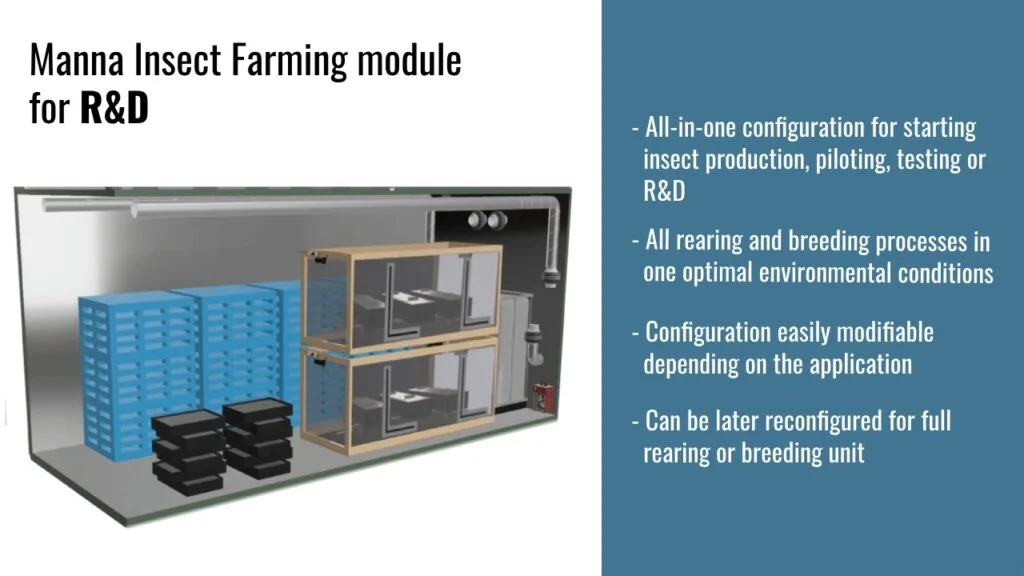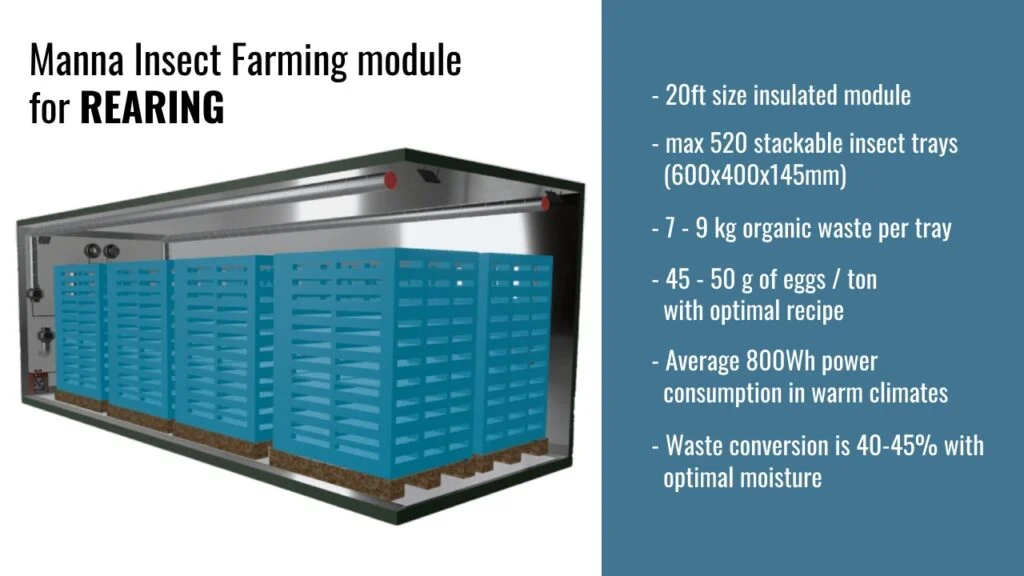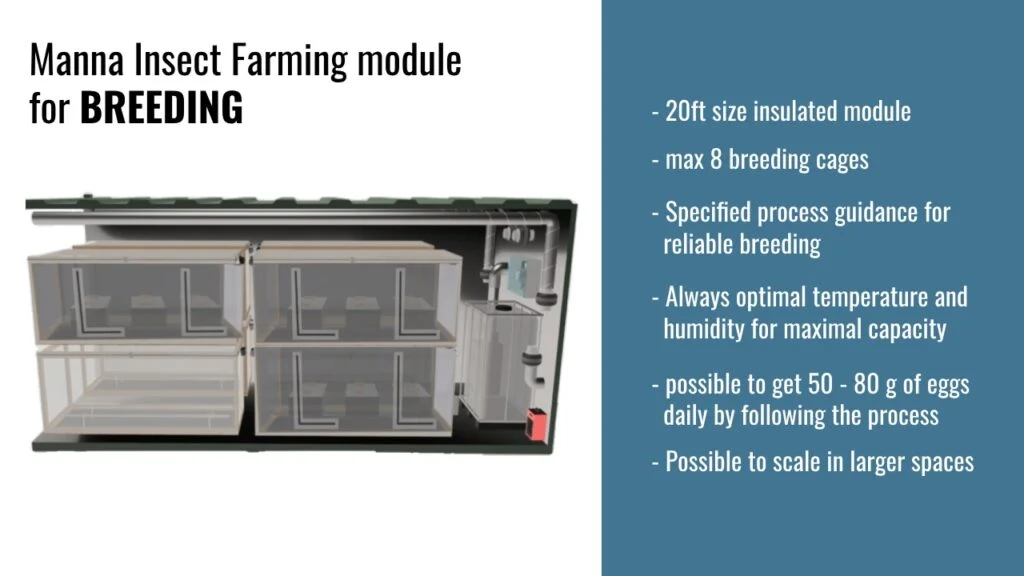Build SCALABLE insect farming module locally
Manna Insect's reference module designs offer the most efficient and risk-free solution for piloting and testing substrates and business models
Create 100% effective BSF growing environment within weeks to get systematic results
Manna Insect has spent 7+ years developing cost-effective BSF farming modules. Now, we provide the expertise to help anyone start systematic and efficient BSF farming without climate risks.
These reference designs can be sourced and build locally by using available materials and equipment.
Reference designs
NOTE: Shipping container in the picture is just an example for the frame can be used and target numbers are according to this size.
Manna offer these as verified reference to accelerate process but MIND technology can be used with basically any size of spaces.
Example production capacity achievable in one rearing cycle with reference farming module and quality substrate
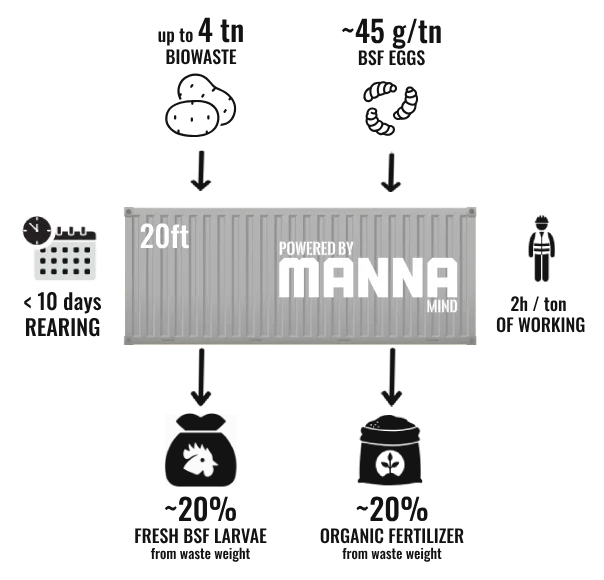
“Optimal climate and dedicated recipe will be converting all organic waste to clean larvae and dry frass, without leftovers from the waste”
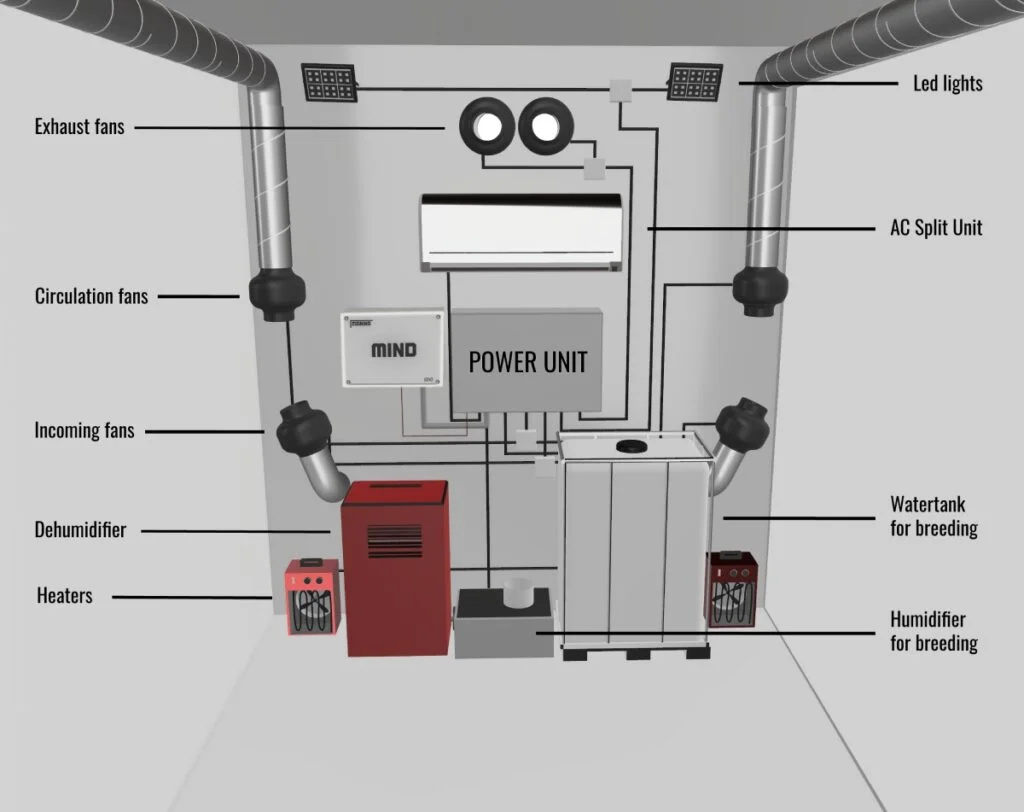
Example of expenses of a pilot farming module
The price of a locally built insect farming module consists of the following components. More detailed list and budgeting tool can be found from Insect FARM hub
- Module & insulation
- Equipment
- Main A/C power unit
- Manna MIND hardware & software
- Insect trays for rearing
- Waste processing and separation
The total cost depends on the customer’s country, insulation requirements, and the availability of equipment and components.
You can create a budget for a locally built module within the Insect Farm Hub under Learning Center → Support.
What you need for the BSF production unit
Shopping list for BSF piloting and testing units
Proper insulation is essential for saving energy and reducing production costs, as it helps maintain optimal internal conditions with minimal energy use. It’s important to select insulation materials that correspond to the external temperature conditions, ensuring the system’s efficiency and cost-effectiveness.
The insulation material needs to be moisture-resistant, such as polyurethane, with all seams sealed and covered. Insulation is necessary in any weather conditions, and using high r-value materials will significantly reduce energy bills. PIR (Polyisocyanurate) or EPS (Expanded Polystyrene) sandwich panels are excellent options to consider for insulation.
Internal airflow is crucial to keeping larvae and flies active at all times. In our tested example installation, we use two long pipes with evenly spaced holes to distribute air uniformly throughout the space.
For ventilation, we use corrosion-resistant or plastic piping with 90-degree elbows to ensure durability and effective air circulation within the container. This setup helps maintain optimal conditions for the insects.
Pilot farming module should be equipped with paired semi-industrial inline duct fans for circulation, exhaust, and incoming air.
Example (Östberg CK160)
Larvae generate significant heat during digestion and movement, making it crucial to effectively lower the internal temperature to prevent overheating.
In compact-sized modules, it’s practical to use cost-effective, consumer-grade, low-power air conditioner split units for high-temperature regulation. These units offer an efficient and affordable solution to maintain the required climate conditions.
AC will be used only for cooling.
During the larvae rearing process, a significant amount of humidity is generated, and it’s essential to prevent water condensation by maintaining an optimal humidity level.
A single-phase semi-industrial dehumidifier (dryer) is highly effective in extracting moisture, ensuring the humidity remains at optimal levels. The recommended capacity for this setup is at least 50 liters per day. This helps to maintain a stable environment for larvae growth and prevent moisture-related issues.
Example (TTK 166 ECO)
Humidifier is essential especially for nursing and breeding spaces but it should be installed also in growing units because it will keep substrate moist enough when larvae are still small.
Small semi-industrial humidifiers can be sourced locally, but it is also possible to assemble one from individual parts using low-cost ultrasonic mist makers, which can be ordered from web shops.
Semi-industrial-grade fan heaters are essential for maintaining a consistent temperature throughout the rearing space. If at any point the temperature drops below 25°C, heating will be required during specific stages of the growth cycle to ensure optimal conditions for larvae development. These heaters help maintain a stable climate, preventing any negative impact on productivity.
Example (min 1 kW)
Basic lighting is essential for maintaining larvae within the trays throughout the entire growth cycle.
Special LED lights designed to mimic sunlight are available for breeding purposes, optimizing mating activities.
The main A/C power unit will be selected based on the size of the space and equipment are used. For example piloting modules we will provide an example list of components, schematics, and instructions for certified electricians to locally assemble the unit.
Example (by Manna Insect)
Rearing production
Stackable insect trays are essential to achieve maximum capacity
Example (600x400x145mm)
Breeding activities
locally build breeding cages, pupa boxes, egg traps and special LED light
- Example (Manna breeding cage design)
- Example (Manna pupa box and egg trap design
- Example (Breeding LED)
Nursing period
Nursing boxes with egg tables
Example (Manna nursing box design)
Separation
There is several possibilities to separate larvae from frass. For small and medium size production one vibrating sieve is enough.
Drying and defatting
There are several methods for drying the larvae, which vary depending on the time and cost ratio.
Manna Insect will provide detailed instructions and how-to guidelines
Other small tools such as weighing scales and crates are necessary for the production process.
One Manna MIND unit will manage a single farming space, whether for rearing, breeding, nursing, or a hybrid setup.
MIND technology consists of two main components:
- Hardware (HW): A set of physical modules that control farming equipment and collect real-time data.
- Software & Cloud Services: A locally installed control system that regulates the environment and transmits data to the cloud, allowing users to monitor conditions, analyze data, and adjust parameters remotely.
The MIND hardware package ranges from $600 to $950, depending on the chosen setup, and is available for direct purchase.
The annual subscription for the MIND software license and cloud services is $990 per unit.

